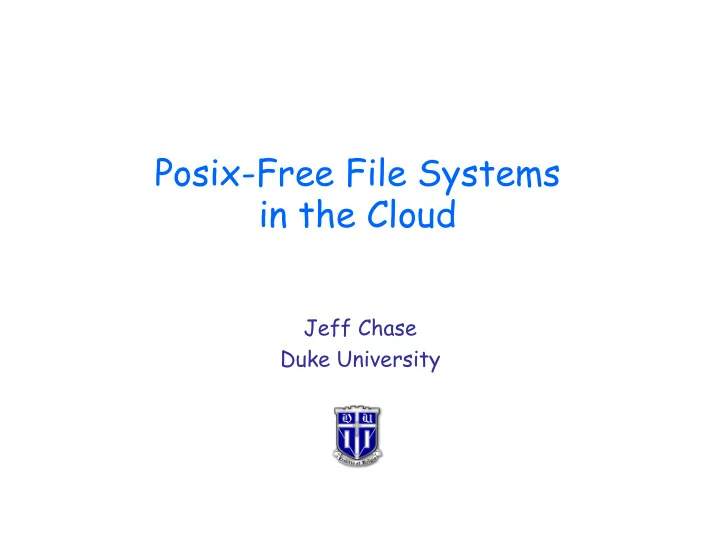

Posix-Free File Systems in the Cloud Jeff Chase Duke University
Beyond Posix • “Filesystem” Posix file system semantics? – open(2) – Hierarchical directories with aliasing – Human-readable symbolic names – Atomic ops on directory tree – Consistency, etc.…. • It has served us for more than 25 years…
Continuum of File/Storage Systems • Personal devices – Small apps, common file system – Seltzer and Murphy, Hierarchical File Systems Are Dead, HotOS 2009. – Do you know where your files are? • Server backbone – Your data lives here; devices are caches. – Storage sits behind client-facing apps – Big $$$ apps and infrastructure • Server storage is breaking out of the straitjacket.
[OSDI 2000, TOCS 2002, USITS 2003] server se r NFS C FS Clie lients nts µ µ se server r se server r Client sends and Storage router module intercepts receives standard NFS. and redirects requests to servers. rename()!&*^%
Server “File Systems” • Trend: storage abstractions as foundational services. – Robust, scalable, etc., etc. • Google FS (GFS SOSP 2003) – “Co-designing applications and the file system” • FS tailored to workload (large files) • Apps program to “new” storage API • Apps compensate for quirks of FS – E.g., record repair at application level
“Have it your way” • Now evolving toward a rich menu of more specialized storage APIs with features to fit. • Key-value stores – Amazon S3, FAWN, etc. • Multi-attribute indexing (tables or property lists) – Amazon SimpleDB, Google BigTable/Megastore • Content-addressable • Temporal/lifecycle management • Etc.
Into the Clouds • Cloud == “data center consolidation” – Pay as you go • Diverging views of storage in the cloud… – Cloud of public services – Cloud of public virtual infrastructure to host private services • E.g., GENI • These choices lead storage system design in different directions.
Some key differences • Accounting must be “designed in” to public services. – (unless they’re free) • Trusted platform vs. trustworthy services – Public services need data protection (whatever that means to the customer). – E.g., strong accountability (FAST 2007) • Elasticity – Public services need some kind of isolation… – For private services, elasticity churn – Controllable (re)scaling and data (re)placement
Other… • Data/vendor lock in with the public service model? – Unless we standardize storage APIs • How to expose/manage location? • How to expose/manage device properties? – Encapsulate at bottom layer? • Risk of feature-creep for public services – Snapshots, cloning, etc. – “Stackable” storage services? • How much customization do we need? – One size fits all vs. let a thousand flowers bloom
Storage Software as a Service • Cloud provider runs common storage services shared by multiple customers. – Thin straw problem? Your application is in the cloud too. – Beware: data lock-in, one-size-fits-all • The storage service must have designed in: – Elastic scaling with performance isolation – Data protection (whatever that means) – Accounting (unless it’s free) – Accountability
Infrastructure as a Service • “Infrastructure as a Service” model – Instantiate virtual machines and virtual devices – Let a thousand flowers bloom – Example: GENI • The storage service must have designed in: – Controllable (re)scaling and data (re)placement • Elastic churn – How to expose location?
GENI Storage • Decouple services from infrastructure – Common “raw” sliverable storage infrastructure? – “Let a thousand flowers bloom.” • Consider separate services separately • Focus on key storage services for workflow – Repositories: Image/appliance, snapshots, source (?) – Operational: auditing, instrumentation (write-once) – On-demand storage for experiment use • Node sliver instantiation (roots)
Recommend
More recommend